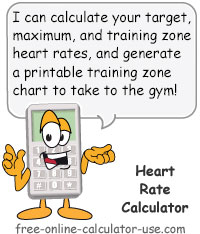IMPORTANT: Numeric entry fields must not contain dollar signs, percent signs, commas, spaces, etc. (only digits 0-9 and decimal points are allowed).
Click the Terms tab above for a more detailed description of each entry.
Step #1:
Enter your current age.
Step #2:
Choose your gender.
Step #3:
Enter your average resting heart rate.
Step #4:
Choose your exercise intensity level.
Step #5:
Indicate whether or not you want a printable training zone chart included in the results.
Step #6:
Click the "Calculate Heart Rate" button and scroll down to view the results.


Follow me on any of the social media sites below and be among the first to get a sneak peek at the newest and coolest calculators that are being added or updated each month.